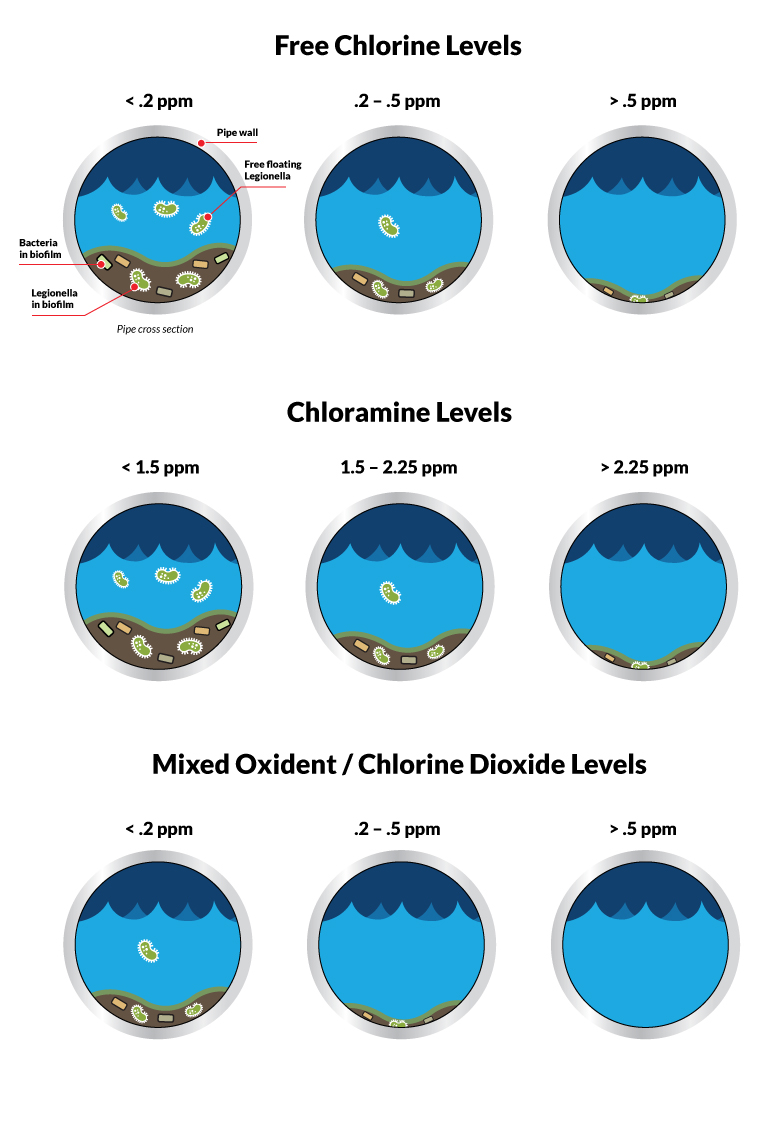Comparison of Secondary Disinfection Systems – Chlorine, Chlorine Dioxide, Mixed Oxidant Solution (MOS), Copper Silver Ionization (CSI)
What are the best methods for Legionella control?
Chlorine can be very effective for pathogen control under the right conditions, and it can be one of the safer chemicals to use. For that reason, it’s very popular among municipalities for water treatment and is a common recommendation for pathogen and Legionella control. However, in some instances, chlorine may not produce the results that you need for effective Legionella and pathogen control.
The quality of water that is being treated with chlorine is a key factor in determining the success of the treatment. Chlorine attacks pathogens and their chemical bonds but also attacks organic materials. For this reason, if your water supply has a significant amount of organic material in addition to the pathogens, the effectiveness of chlorine is greatly reduced because a large percentage of chlorine is used as it attacks the organic material. The below chart illustrates how chlorine is affected by unfiltered water.
- Pair the chlorine treatment with a filtration solution, such as the Legionella Control Systems Annihilator™, microfiltration, or ultrafiltration. This will greatly improve the effectiveness of your chlorine treatment because it removes 99.99% of organic particles from the water before the chlorine is introduced, leaving the chlorine to act upon the pathogens.
How is this issue solved? There are three excellent Legionella mitigation and pathogen control solutions to consider:
- Utilize chlorine dioxide as an alternative solution to chlorine for your Legionella and pathogen control. As illustrated below, chlorine dioxide does not have the same issue with organics in the water supply. Only a small percentage of the chlorine dioxide is consumed by organics, leaving more for disinfection. The challenge with chlorine dioxide is that it can be more dangerous to handle, it can only be dosed at .8 ppm (compared to 4 ppm with chlorine) and the dosing needs to be closely monitored due to its toxicity. Lastly, chlorine dioxide is quite expensive compared to chlorine.
- Use a mixed oxidant solution (MOS) instead of chlorine or chlorine dioxide. Our mixed oxidant solution (MOS) has an advantage over chlorine because it is able to cut through and kill biological contaminants in biofilm. Moreover, mixed oxidant solution is just as or more effective than chlorine dioxide for Legionella and pathogen control, but it is much safer to store, handle and dose than chlorine dioxide and can be injected at 4 ppm instead of only .8 ppm for chlorine dioxide.
Which pathogen or Legionella control solution is best for you? As a truly independent company that is not tied to particular chemical approach, Legionella Control Systems can help you choose the best option for your budget and pathogen control needs. Contact us today for guidance on waterborne pathogen control, Legionella mitigation, Legionnaires outbreak remediation, water testing, Legionella risk assessments, water management programs, and other water safety issues.










